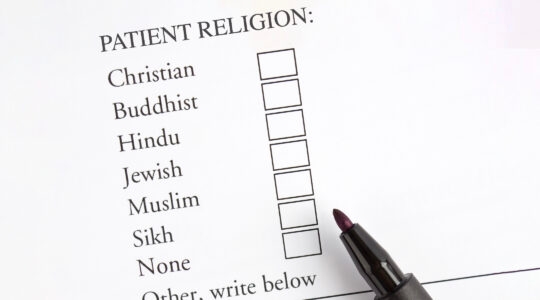Candlelighting, Readings:
Shabbat candles: 5:02 p.m.
Torah: Ex. 27:30-30:10
Haftarah: Ezekiel 43:10-27
Havdalah: 6:03 p.m.
The special vestments made for Aaron, the Kohen Gadol, in his role as High Priest, comprise a grand costume: “You shall make vestments of sanctity for Aaron your brother, for glory and splendor” [Exodus 28:2]. They were made of precious and semi-precious stones, gold chains, fine linen, turquoise, purple, and scarlet wool, and real gold thread. It is interesting that the priests had vestments befitting royalty but Moses had no costume or symbol of kingship. It is also interesting that the High Priest’s vestments were made of mixed fibers: wool and linen, which are specifically prohibited to us in Leviticus 19:19 and Deuteronomy 22:11, the prohibition known as shatnez (combined fibers).
Moses was humble, we are told, the most humble person on earth [Numbers 12:3]. His royalty was inner, not outer. We are asked to emulate Moses, not the High Priest in this matter.
Why is Aaron commanded to wear mixed fibers while we are prohibited from doing so? Aaron was commanded to look grand and we, as individuals are asked not to try to look like priests or to look royal. We are urged to cultivate humility as an important value, not to appear to be too wealthy, royal, or grand. When I hear about people who buy ostentatiously lavish lifestyles for themselves, I often feel sorry for them. That’s royalty on the outside. Those who need royalty on the outside may be compensating for a lack of royalty on the inside.
True outer royalty is always collective, not personal. Royalty comes from conferring authority upon someone to represent the nation, the group, or the tribe. Rabbi Samson Raphael Hirsch, in his commentary [regarding Lev. 28:42-43], pointed out that the priests’ vestments were supplied by, made by, and owned by the people. When not serving the nation, the Talmud tells us [Yomba 69a] that the priests were not to wear their vestments to go about the town. According to the tradition, Aaron was a regular sort of person when he was not at work.
No one can be outwardly royal alone: royalty is always about the group. Inward royalty is another matter. We can and should be royal on the inside, individually. Inner value is true and lasting value. Outer royalty is fleeting at best, and usually elusive. It is comparative and subjective, and has no objective reality. It is a costume we put on and take off, because none of us is really royal on the outside. Remember the adage, no one is a hero to his valet? The trappings of wealth and power are even seen, by the rabbis of the Mishnah, as a hindrance to spiritual progress [Avot 2:10, 4:21, 6:4].
Rather than admiring the exterior, the Torah teaches us to focus on the interior: that which provides lasting satisfaction, happiness, harmony, and love. We are all royal on the inside, if only we could see that our divinity is a reflection of God’s radiance. The full beauty of a human soul is too dazzling for us ever to comprehend. We are already royalty, descendants from the Eternal Holy Presence. We truly need no outer emblems of self-worth.
Our task is to convince ourselves of the greatness within, by cultivating nobility in Godly attributes: taking care of others, acts of kindness, and compassion. The less we need to prove our worth and status to the world, the happier we become, letting our inner royalty shine forth. Inner royalty is magnetic. We respond to true inner nobility in another person because we admire and feel a kinship with God’s attributes of mercy, graciousness, kindness, integrity and generosity. It needs no trappings.
May we find within the royalty we seek, needing less and less of the outer symbols our society seems to value. May inner holiness be the royalty we seek, and may we find it, with God’s great blessing.
Rabbi/Cantor Jill Hausman is spiritual leader of The Actors’ Temple in Manhattan.
The New York Jewish Week brings you the stories behind the headlines, keeping you connected to Jewish life in New York. Help sustain the reporting you trust by donating today.




